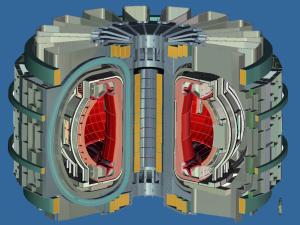ITER ... and then what?
In the world of fusion research, experimental programs aren't carried out consecutively ... they overlap. Physicists were already trying to imagine ITER (under the name of INTOR) when construction of the European JET tokamak was just getting underway in the early 1980s; now, work is underway on the conception of the next-stage machine, DEMO, while the ITER installation is still years from finalization.

DEMO is the machine that will bring fusion energy research to the threshold of a prototype fusion reactor. After ITER—the machine that will demonstrate the technological and scientific feasibility of fusion energy—DEMO will open the way to its industrial and commercial exploitation.
The term DEMO describes more of a phase than a single machine. For the moment, different conceptual DEMO projects are under consideration by all ITER Members (China, the European Union, India, Japan, Korea, Russia and, to a lesser extent, the United States). It's too early to say whether DEMO will be an international collaboration, like ITER, or a series of national projects.
ITER will be the school where physicists and engineers will learn to build DEMO. In fact, it's the essence of the international collaboration that has formed behind the project: in ITER, each participating member will acquire the experience that will allow it to proceed, back home, with the next step.
Last December during the Monaco ITER International Fusion Energy Days (MIIFED 2013), the ITER Members presented their projects for DEMO. Although the timeline, the technical specifications and the level of determination varied from one Member to the next, the objective was the same for all: building the machine that will demonstrate industrial-scale fusion electricity by 2050.
Japan, Korea, India, Europe and Russia presented a clear calendar in Monaco, stating their intention to begin building DEMO in the early 2030s in order to operate it in the 2040s.
China, after having explored physics and technological issues in a test reactor built in the 2020s (the China Fusion Engineering Test Reactor, CFETR), also plans to launch the construction of DEMO in the 2030s.
The government of the United States—for reasons related to the organization of research funding in that country—has not yet officially engaged in a DEMO project. The fusion community, for its part, considers that two intermediary machines are necessary before DEMO: a technological test facility and another facility with more scientific goals.
What might the future DEMO machine look like? The conceptual designs all sketch out a machine that is larger than ITER. The large radius ("R") of the plasma cross-section—which determines the size of the machine—ranges from 6 to 10 metres. In comparison, ITER's "R" measures 6.2 metres and that of the largest tokamak in operation, JET, measures half that.
How powerful will they be? Again, the designs vary—from 500 MW for the European DEMO to 1500 MW for the Japanese DEMO. (A 1500 MW machine would be the practical equivalent of a next-generation fission reactor of the type EPR that is under construction in Flamanville, France or Olkiluoto, Finland.)
And their ambition? For some Members, DEMO will be a pre-industrial demonstration reactor; for others, it will be a quasi-prototype that requires no further experimental step before the construction of an industrial-scale fusion reactor.
In this vast panorama of possibility, one project stands out from the others: the Russian pre-DEMO project, a hybrid that would combine the principles of fission and those of fusion within the same machine.
A bit of physics is necessary to understand. Within ITER, each fusion reaction will produce one high-energy neutron. The impact of this neutron on the vessel wall will produce the heat that, in future machines, will be used for the production of energy.
Some physicists believe that the neutrons produced during fusion could be exploited in a different manner. They envisage using the energy of the neutrons for two purposes: to produce nuclear fuel for conventional fission reactors (through interaction with heavy elements like thorium or depleted uranium) and also to "break down" nuclear waste.
This is the path explored by Russian research today. As it was described in Monaco, the machine would be a hybrid reactor baptized DEMO-FNS (for Fusion Neutron Source). A small tokamak (R=1.9 m) would generate the neutrons necessary to producing fission fuel and to transmuting radioactive waste.
Although plans are on the table for the next-step device, nothing has yet been frozen. The return on experience from ITER operation will determine the final choices made for DEMO.


